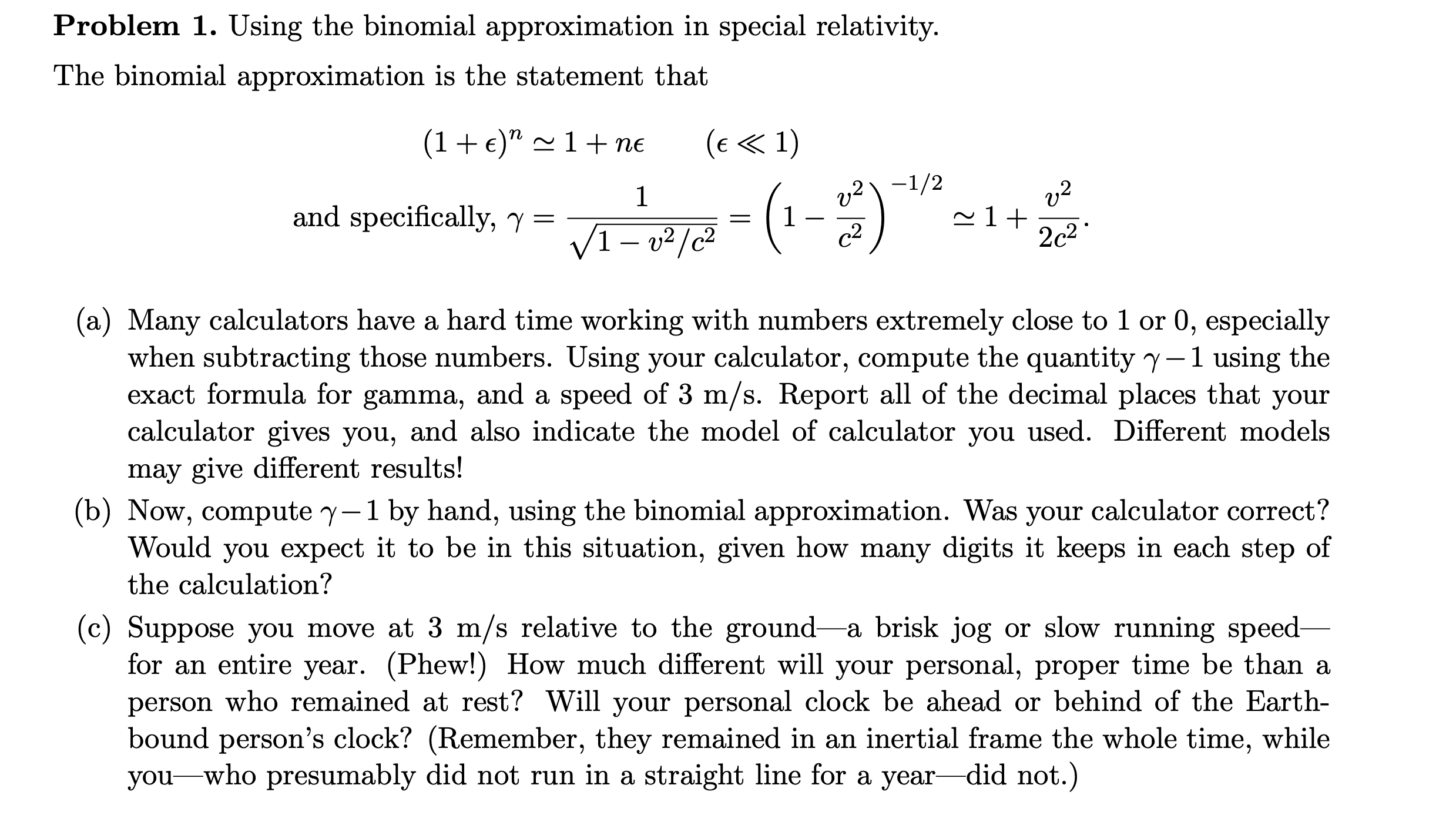Problem 1. Using the binomial approximation in special relativity. The binomial approximation is the statement that (1+ €)" ~ 1 + ne (e « 1) v2\ -1/2 v2 and specifically, y = V1- v²/c² c2 2c2 (a) Many calculators have a hard time working with numbers extremely close to 1 or 0, especially when subtracting those numbers. Using your calculator, compute the quantity y-1 using the exact formula for gamma, and a speed of 3 m/s. Report all of the decimal places that your calculator gives you, and also indicate the model of calculator you used. Different models may give different results! (b) Now, compute y-1 by hand, using the binomial approximation. Was your calculator correct? Would you expect it to be in this situation, given how many digits it keeps in each step of the calculation? (c) Suppose you move at 3 m/s relative to the ground-a brisk jog or slow running speed- for an entire year. (Phew!) How much different will your personal, proper time be than a person who remained at rest? Will your personal clock be ahead or behind of the Earth- bound person's clock? (Remember, they remained in an inertial frame the whole time, while you-who presumably did not run in a straight line for a year-did not.)
Problem 1. Using the binomial approximation in special relativity. The binomial approximation is the statement that (1+ €)" ~ 1 + ne (e « 1) v2\ -1/2 v2 and specifically, y = V1- v²/c² c2 2c2 (a) Many calculators have a hard time working with numbers extremely close to 1 or 0, especially when subtracting those numbers. Using your calculator, compute the quantity y-1 using the exact formula for gamma, and a speed of 3 m/s. Report all of the decimal places that your calculator gives you, and also indicate the model of calculator you used. Different models may give different results! (b) Now, compute y-1 by hand, using the binomial approximation. Was your calculator correct? Would you expect it to be in this situation, given how many digits it keeps in each step of the calculation? (c) Suppose you move at 3 m/s relative to the ground-a brisk jog or slow running speed- for an entire year. (Phew!) How much different will your personal, proper time be than a person who remained at rest? Will your personal clock be ahead or behind of the Earth- bound person's clock? (Remember, they remained in an inertial frame the whole time, while you-who presumably did not run in a straight line for a year-did not.)
Related questions
Question
Can you answer problem 1 part a?

Transcribed Image Text:Problem 1. Using the binomial approximation in special relativity.
The binomial approximation is the statement that
(1+ €)" ~ 1 + ne
(e « 1)
v2\ -1/2
v2
and specifically, y =
V1- v²/c²
c2
2c2
(a) Many calculators have a hard time working with numbers extremely close to 1 or 0, especially
when subtracting those numbers. Using your calculator, compute the quantity y-1 using the
exact formula for gamma, and a speed of 3 m/s. Report all of the decimal places that your
calculator gives you, and also indicate the model of calculator you used. Different models
may give different results!
(b) Now, compute y-1 by hand, using the binomial approximation. Was your calculator correct?
Would you expect it to be in this situation, given how many digits it keeps in each step of
the calculation?
(c) Suppose you move at 3 m/s relative to the ground-a brisk jog or slow running speed-
for an entire year. (Phew!) How much different will your personal, proper time be than a
person who remained at rest? Will your personal clock be ahead or behind of the Earth-
bound person's clock? (Remember, they remained in an inertial frame the whole time, while
you-who presumably did not run in a straight line for a year-did not.)
Expert Solution
This question has been solved!
Explore an expertly crafted, step-by-step solution for a thorough understanding of key concepts.
This is a popular solution!
Trending now
This is a popular solution!
Step by step
Solved in 2 steps with 2 images
